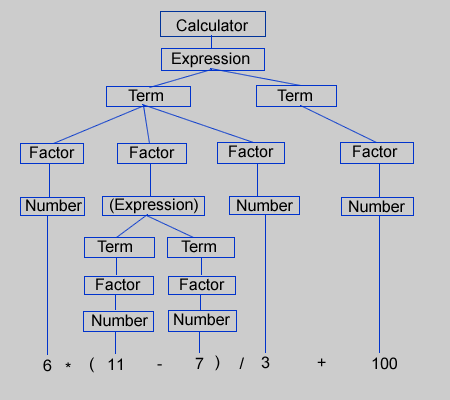

options {
IGNORE_CASE = false;
OPTIMIZE_TOKEN_MANAGER = true;
}
PARSER_BEGIN(cal)
import java.io.*;
import java.util.*;
public class cal {
public static void main(String[] args) throws ParseException,
FileNotFoundException
{
if ( args.length < 1 ) {
System.out.println("Please pass in the filename for a parameter.");
System.exit(1);
}
cal parser = new cal( new FileInputStream(args[0]) );
parser.calculator();
System.out.println("Parse completed.");
}
}
PARSER_END(cal)
SKIP: /* Whitespace */
{
"\t"
| "\n"
| "\r"
| " "
}
TOKEN:
{
<LPAREN: "(">
| <RPAREN: ")">
| <ADD_OP: "+" | "-">
| <MULT_OP: "*" | "/">
| <NUMBER: (["0"-"9"])+>
}
void calculator() :
{}
{
expression() < EOF>
{System.out.println("Calculator");}
}
void expression() :
{}
{
term() (<ADD_OP> term())*
{ System.out.println("Expression");}
}
void term():
{}
{
factor() (<MULT_OP> factor())*
{ System.out.println("Term");}
}
void factor():
{}
{
(<LPAREN> expression() <RPAREN>
|number())
{ System.out.println("Factor");}
}
void number() :
{}
{
<NUMBER>
{ System.out.println("NUMBER");}
}
NUMBER Factor NUMBER Factor Term NUMBER Factor Term Expression Factor NUMBER Factor Term NUMBER Factor Term Expression Calculator Parse completed.
